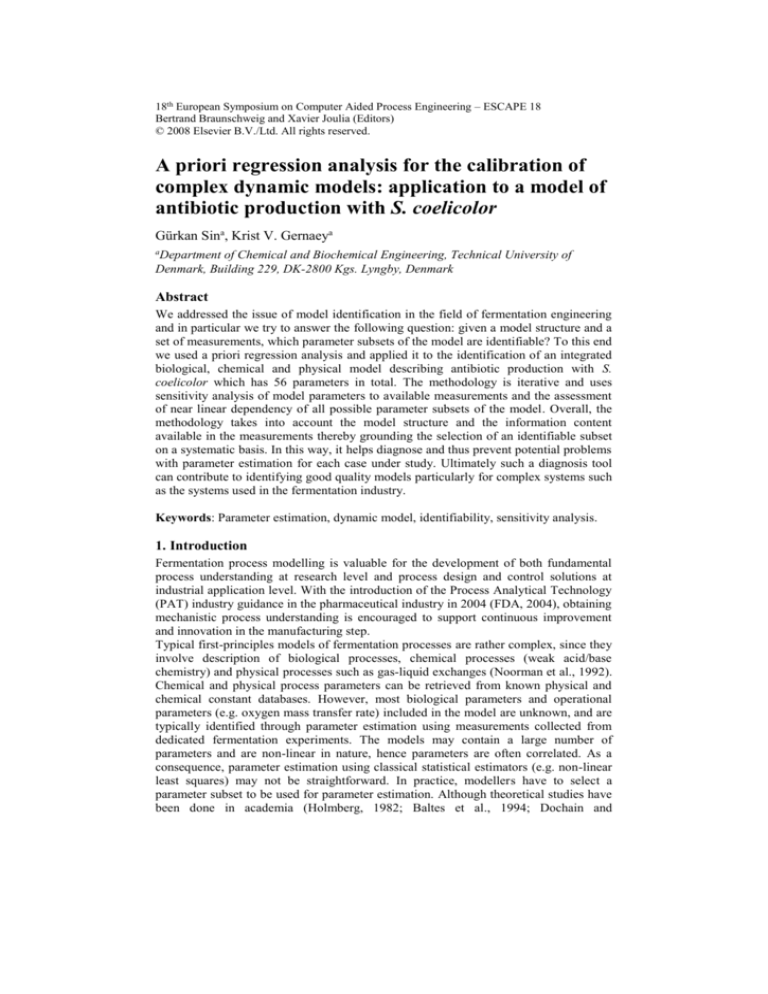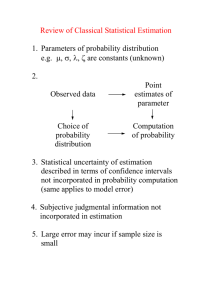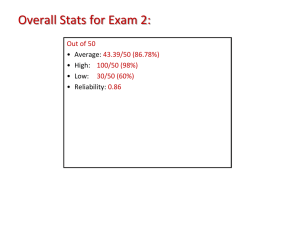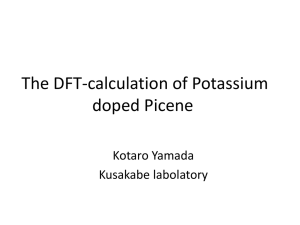
18th European Symposium on Computer Aided Process Engineering – ESCAPE 18
Bertrand Braunschweig and Xavier Joulia (Editors)
© 2008 Elsevier B.V./Ltd. All rights reserved.
A priori regression analysis for the calibration of
complex dynamic models: application to a model of
antibiotic production with S. coelicolor
Gürkan Sina, Krist V. Gernaeya
a
Department of Chemical and Biochemical Engineering, Technical University of
Denmark, Building 229, DK-2800 Kgs. Lyngby, Denmark
Abstract
We addressed the issue of model identification in the field of fermentation engineering
and in particular we try to answer the following question: given a model structure and a
set of measurements, which parameter subsets of the model are identifiable? To this end
we used a priori regression analysis and applied it to the identification of an integrated
biological, chemical and physical model describing antibiotic production with S.
coelicolor which has 56 parameters in total. The methodology is iterative and uses
sensitivity analysis of model parameters to available measurements and the assessment
of near linear dependency of all possible parameter subsets of the model. Overall, the
methodology takes into account the model structure and the information content
available in the measurements thereby grounding the selection of an identifiable subset
on a systematic basis. In this way, it helps diagnose and thus prevent potential problems
with parameter estimation for each case under study. Ultimately such a diagnosis tool
can contribute to identifying good quality models particularly for complex systems such
as the systems used in the fermentation industry.
Keywords: Parameter estimation, dynamic model, identifiability, sensitivity analysis.
1. Introduction
Fermentation process modelling is valuable for the development of both fundamental
process understanding at research level and process design and control solutions at
industrial application level. With the introduction of the Process Analytical Technology
(PAT) industry guidance in the pharmaceutical industry in 2004 (FDA, 2004), obtaining
mechanistic process understanding is encouraged to support continuous improvement
and innovation in the manufacturing step.
Typical first-principles models of fermentation processes are rather complex, since they
involve description of biological processes, chemical processes (weak acid/base
chemistry) and physical processes such as gas-liquid exchanges (Noorman et al., 1992).
Chemical and physical process parameters can be retrieved from known physical and
chemical constant databases. However, most biological parameters and operational
parameters (e.g. oxygen mass transfer rate) included in the model are unknown, and are
typically identified through parameter estimation using measurements collected from
dedicated fermentation experiments. The models may contain a large number of
parameters and are non-linear in nature, hence parameters are often correlated. As a
consequence, parameter estimation using classical statistical estimators (e.g. non-linear
least squares) may not be straightforward. In practice, modellers have to select a
parameter subset to be used for parameter estimation. Although theoretical studies have
been done in academia (Holmberg, 1982; Baltes et al., 1994; Dochain and
2
Sin and Gernaey
Vanrolleghem, 2001), this choice of a parameter subset to be estimated is often done
using expert judgement and previous experiences with modelling.
To resolve this issue and facilitate the identification of fermentation models in practice,
in this study a priori regression analysis is applied to perform a systematic parameter
subset selection to be used for parameter estimation (PE). The methodology is iterative
and relies on the use of a sensitivity analysis of model parameters to available model
outputs (measurements). The method is evaluated on a complex integrated dynamic
model describing antibiotic production by S. coelicolor.
2. Materials and Methods
The fermentation model was implemented and simulated in Matlab (R14, Mathworks).
The identifiability methodology (see Table 1) was implemented in Matlab as well.
Table 1. Different steps of the identifiability methodology of Brun et al. (2002)
Identifiability steps
Description
Non-dimensional
sensitivity matrix,
s ij
S sij
Normalized sensitivity
matrix,
~ ~
S
sij
j y i
y i
where
is the absolute sensitivity of the
j
sc i j
model output y to model parameter j at time instant i. j is
parameter uncertainty and sci is a scaling factor.
s ij
~
sij
sj
where s j
is the Euclidian norm of the sensitivity of
the jth column in the S matrix
Sensitivity measure,
jmsqr
Collinearity index, K
msqr
j
1
n
K
1
n
s2
i 1 ij
The higher, the more sensitive j is.
~
~
min K
where min K is the minimum eigenvalue of
~ ~
the normalized subset matrix S TK S K . K measures the extent of
linear dependency between the sensitivity functions. If the
sensitivity functions are orthogonal K is equal to unity otherwise it
approaches infinity as the functions become more linearly
dependent.
Determinant measure,
K
ρ K det(S TK S K )1/ 2 K is the determinant of the n x K subset
matrix of S. This measure in a way combines the information from
jmsqr and K, and is a relative measure to compare identifiability
(high value for identifiable parameter subsets).
´
2.1. Integrated fermentation model
The fermentation model used in this study is based on first-principles and describes
interaction between biological, chemical and gas-liquid exchange processes occurring in
a batch cultivation reactor of S. coelicolor for antibiotic production (Sin et al., 2008).
The model provides dynamic predictions of macromolecular compounds in the batch
reactor including the substrate glucose, biomass, oxygen, base addition for pH control
and off-gas CO2 among others.
A priori regression analysis for the calibration of complex dynamic models
2.2. A priori regression analysis methodology
The methodology developed in Brun et al. (2002) was used in this study. This approach
is based on a local sensitivity analysis and calculates three identifiability measures for
model parameters (jmsqr, K, K) by following the different steps summarized in Table 1.
Finally a parameter subset is said identifiable, if it complies with the three identifiability
measures: (i) high sensitivity measure, (ii) below an empirically determined threshold
for the Collinearity index, (usually below 10-15) and (iii) high determinant measure.
3. Results and Discussions
3.1. The sensitivity measure msqr
In this step, the sensitivity of model parameters (56) on glucose, oxygen, biomass,
actinorhodin, base addition and off-gas CO2 model outputs was evaluated. The
parameters were then clustered with the K-means algorithm with 2 classes – based on
the sensitivity measures – thereby separating significant from less significant
parameters. Two important observations could be made from the results (data not
shown): (1) Only few out of 56 parameters have influential effects on the model
outputs; (2) Different model outputs have sensitivity for different model parameters.
This is useful information in view of parameter estimation: parameters can indeed only
be identified if the measured model outputs are sensitive to the parameters to be
identified.
Next, assuming that all six model outputs were available for parameter estimation, we
have summed up the sensitivity measure of each parameter on each model output
thereby obtaining an overall sensitivity measure. Using the overall sensitivity measure,
a second clustering was done. Results are shown in Figure 1. The significant parameters
obtained in this way were considered for the collinearity analysis below.
Sensitive cluster of parameters
Less sensitive cluster of parameters
Figure 1. Parameter ranking results based on msqr sensitivity measure.
3.2. Collinearity index and determinant measure
In total 15 parameters (see above) were considered for assessing the identifiability
measures. All possible combinations of parameter subset sizes were evaluated. The
3
4
Sin and Gernaey
identifiability measures calculated for each parameter subset combination in each subset
of size K are summarised in Table 2. One observes that as the parameter subset size
increases, the collinearity index increases and the determinant measure decreases (Table
2). The latter indicates poor identifiability of the parameter subset hence potential
difficulties in parameter estimation. Overall this pattern was observed also in other
identifiability studies of complex models (Brun et al., 2002; Sin and Vanrolleghem,
2007), which implies – rather logically – that there is a certain limit to the number of
identifiable parameters under given measurements. This conclusion particularly applies
for complex dynamic models with respect to limited data availability for identification.
For a parameter subset to be identifiable, the collinearity index should be below an
empirically determined threshold (Brun et al., 2002; Sin and Vanrolleghem, 2007).
Hence using a strict threshold value as 10 for the K, one observes that there are many
identifiable parameter subsets with different sizes. However, the number of the
identifiable parameter subsets decreases sharply as the subset size increases leading to
unidentifiable subset sizes (Table 2).
For this study, the largest identifiable subset size was found to be 12. In view of model
identification, one would like to estimate as many parameters as possible from the
available measurements, and hence the obvious choice would be a parameter subset
with the largest size. On the other hand, the largest identifiable subset size contains 10
potentially identifiable subsets each with different combinations of sensitive parameters.
At this stage one can use each of those 10 subsets in a parameter estimation procedure,
evaluate the resulting best model fits, and finally choose the identifiable subset
according to the minimum sum of squared error (Brun et al., 2002). Alternatively, one
can use an expert judgment to select the identifiable subset which contains parameters
that are otherwise expensive to measure experimentally (Sin and Vanrolleghem, 2007).
Table 2. Summary of the identifiability results for the sensitive parameters (see text)
Subset Total no. of
%
Minimum Maximum K of the
K of
class
subset
identifiable
K
K
min
the max
combinations
subsets
subset
subset
2
105
97.1
1.1
35.6
1.0
0.5
3
455
91.9
1.3
39.7
1.0
0.4
4
1365
84.5
1.4
40.4
0.9
0.5
5
3003
75.1
1.6
41.4
0.9
0.5
6
5005
63.9
1.7
43.2
0.9
0.6
7
6435
51.5
1.8
44.5
0.9
0.6
8
6435
38.8
2.1
45.8
0.9
0.6
9
5005
26.5
3.0
47.3
0.8
0.5
10
3003
15.8
4.3
47.6
0.8
0.5
11
1365
7.5
5.0
48.0
0.8
0.6
12
455
2.2
6.0
48.3
0.7
0.6
13
105
0.0
17.2
48.4
0.7
0.6
14
15
0.0
24.5
48.5
0.6
0.6
15
1
0.0
48.6
48.6
0.6
0.6
3.3. Effect of measurement quantity and type on parameter identifiability
The quantity and type (what variable is measured?) of available measurements are
important as they provide the source of information for the identification of parameters.
It was therefore evaluated how the parameter identifiability is affected by the sampling
A priori regression analysis for the calibration of complex dynamic models
frequency and the selected type of available measurements. To this end, the
identifiability measure, K, was evaluated under two scenarios. In the first scenario, we
increased the measurement frequencies of all 6 measured variables from one data point
every hour to one data point every 15 minutes. In the second scenario, we evaluated K
by considering that only one measured variable was available for parameter estimation.
The results from these two scenarios were then assessed by summarising the identifiable
parameter subsets using the abovementioned threshold of 10 for the collinearity index,
and are plotted in Figure 2 as percentage of identifiable subsets relative to the total
number of possible subsets of parameters for each subset size.
Increasing the measurement frequency has improved remarkably the identifiability of
the parameters in two ways: (i) almost all possible parameter subsets equal to or below a
size of 9 become identifiable and (ii) the maximum identifiable subset size increased
from 12 to 14. This result is the consequence of the increased information content of the
measurements. On the other hand, when only one variable is used for parameter
estimation, the information content of the data set decreases sharply and hence restricts
the number of identifiable parameters to much smaller sizes, e.g. a subset of 5
parameters when only glucose measurements are used. Further, oxygen measurements
appeared to contain more information than the other individual measurements allowing
6 parameters to be identified, while the antibiotic measurements allowed only 3
parameters to be identified when used alone. The overall importance ranking of
measured variables was found as follows: oxygen, base, glucose, off-gas CO2, biomass
and finally antibiotic measurements. This indicates that simple and relatively cheap
methods for collection of on-line oxygen and base addition data are still valuable for
identification of fermentation models.
Figure 2. Effect of measurement type and frequency on the identifiability results
Overall the information provided by these identifiability measures ( K and msqr) are
indeed valuable especially as a diagnosis tool prior to performing parameter estimation
in complex models. When identifying a complex model in practice or in a research
project, the procedure is often iterative and time-consuming and the modeller faces the
question of which parameters to estimate given a data set. The procedure evaluated here
helps overcome these problems and provides a tailor-made identifiable parameter subset
for each model and measurement data combination.
Moreover it also provides useful insight into the mathematical problem at hand, e.g. the
identifiability measures explain what otherwise causes the parameter estimation failure
5
6
Sin and Gernaey
in such complex models. As a future outlook, the identifiability measures can also be
used as criteria to design smart and intelligent data collection schemes, i.e. in the design
of experiments for model identification. Last, the overall procedure can be automated to
a large extent and be incorporated to parameter estimation algorithms thereby
facilitating the identification of models.
4. Conclusions
An a priori regression analysis method was successfully evaluated on a complex
dynamic fermentation model containing around 56 parameters. In the first step, the
sensitivity measure, msqr, classified in total 15 parameters to be the most influential on
the available measurements (6 variables collected from routine fermentation
monitoring). In the second step, the identifiability measure, K, revealed that many
identifiable parameter combinations exist, however the largest identifiable subsets had a
size of 12 parameters. When the frequency of the available measurements (quantity)
was increased 4-fold, parameter identifiability improved remarkably and allowed 2
additional parameters to be identified from the data. Overall the proposed methodology
was able to quantify the information content of the available data, and is thereby very
helpful in finding a parameter subset that can be reliably identified by routine parameter
estimation. Ultimately this tool can help modellers to better understand and diagnose
parameter estimation failures often encountered in practice, thereby facilitating the
identification of reliable models.
5. Acknowledgement
The research work of Dr. Gürkan Sin was financed by a H.C. Ørsted postdoctoral
fellowship of the Technical University of Denmark.
References
Baltes M., Schneider R., Sturm C. and Reuss M. (1994) Optimal experimental design for
parameter estimation in unstructured growth models. Biotechnol. Prog., 10, 480-488.
Brun R., Kühni M., Siegrist H., Gujer W. and Reichert P. (2002) Practical identifiability of
ASM2d parameters-systematic selection and tuning of parameter subsets. Wat. Res., 36, 41134127.
FDA (2004) PAT – A framework for innovative pharmaceutical development, manufacturing and
quality assurance. Guidance for Industry. (http://www.fda.gov/cder/ guidance/index.htm).
Dochain D. and Vanrolleghem P.A. (2001). Dynamical modelling and estimation in wastewater
treatment processes. IWA Publishing, London, UK.
Holmberg A. (1982) On the practical identifiability of microbial growth models incorporating
Michealis-Menten type nonlinearities. Math. Biosci., 62, 23-43.
Noorman H.J., Luijkx G.C.A., Luyben K.Ch.A.M. and Heijnen J.J. (1992). Modeling and
experimental validation of carbon dioxide evolution in alkalophilic culture. Biotech. Bioeng.
39, 1069-1079.
Sin G., Ödman P., Petersen N., Eliasson Lantz A. and Gernaey K.V. (2008). Matrix notation for
efficient development of first-principles models within PAT applications: Integrated modeling
of antibiotic production with S. coelicolor. Biotech. Bioeng.. (Submitted).
Sin G. and Vanrolleghem P.A. (2007) Extensions to modeling aerobic carbon degradation using
combined respirometric-titrimetric measurements in view of activated sludge model
calibration. Wat. Res., 41, 3345-58.









